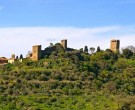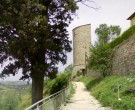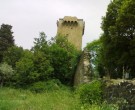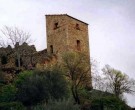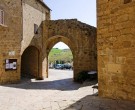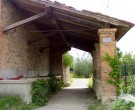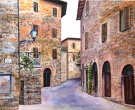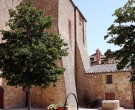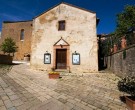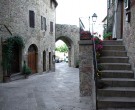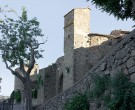> Home > What to visit > Old Town

Monticchiello Pienza
OLD TOWN
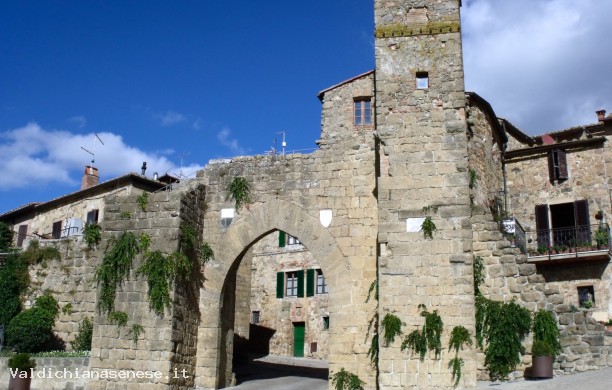
PHONE NUMBERS AND TIMES
Monticchiello
Business card (vCard)
Since Etruscan and Roman times, Montichiello had been a central link for the many roads that connected town centers and communities in the area. It still preserves the sober characteristics of the medieval fortresses . The village rises on a hill immersed in the Sienese countryside, in the township of Pienza. From the countryside, the first thing that one notices is the tower of the castle that rises stocky and sturdy above the roofs of the houses. The ruins of the perimeter walls and the beheaded towers reveal themselves only as one gets closer to the castle. Of dubious Roman origins, that make the name Montichiello derive from the Latin Mons Cloelii , revealing it as a territory belonging to Gens Cloelia, we find the first documented traces of Montichiello in 973 , in a transfer deed by Lamberto Aldobrandeschi to the Badia Amiantina. But until the XIIIth century, news about the village are quite rare. A deed of 1156 is known, that certifies that Count Paltonieri di Forteguerra donated the village to Pope Adrian of Montichiello, who , in turn, gave it back to benifit to the Count . Later on, it seems that the castle was handed over by the Apostolic Center to the Order of the Teutonic Knights. Around 1175, the political influence of the Township of Siena extends to Montichiello. A clause of the Peace Treaty stipulated between Sienese and Florentines, in 1208, and the imposition on Montichiello of a tribute to finance the Sienese debt, testify that during that year the castle was definitely part of the territory of Siena. In 1233, the ambassadors of Montichiello swore an alliance with the bailiff of Siena against Montepulciano, making the commitment of not allowing any of the wives or sons of their enemies to reside in the castle. During the war, Montichiello was ravaged by the Orvieto people, and during the peace treaties in 1235, the Sienese demanded an indemnity. During the entire XIIIth century there were numerous boundary disputes between Montichiello and Montepulciano , during which Siena acted as a referee. In 1250, the construction of the upper part of the castle, the church and the restoration of the perimeter walls took place. During this period, the township acquires laws written in a popular language; trade and craftsmanship develops, giving way to the most prosperous period in the village. The decline of Montichiello begins with the Spanish-French war around the middle of 1500. The strenuous resistance of Charles V’s army is widely recollected. Courage and an honourable surrender was recognized to the people of Montichiello, forced to face the enemy armed at times only with stones . It was with the fall of the Sienese Republic in 1559, that Montichiello fell under the Medici and gradually lost more and more its past role and importance . On June 26th 1778,during the civil and administrative reformations of the State of Tuscany, the Grand Duke Pietro Leopoldo decrees the suppression of the township of Montichiello and embodies it to the township of Pienza. On April 6th, 1944, the Prefect of Siena sends to Monticchiello, a large number of men to face the Partisans , camped near the village. The conflict forced the fascist forces to withdraw. The next day, the German raking struck: the soldiers entered the homes by force , and gathered the inhabitants outside the village gate. The massacre was avoided , thanks to Irma Angheben, German wife of a landowner in Montichiello, with the help of the parish priest. Nowadays, Montichiello is surrounded by perimeter walls that have only partially survived. Various types of towers, mainly beheaded, stand among the surviving remains of the perimeter walls. The main entrance is through Porta Sant’ Agata, with a lancet arch, protected by two towers. The code of arms of Siena embellishes the gate. The town plan lacks narrow alleys , but it’s full of squares and stone paved spaces. It’s in these spaces, that every summer, there’s the performance of the “Teatro Povero” ( Poor Theatre), written, directed and performed by the village people, where the inhabitants of Montichiello, by representing themselves, testify their reality, and the authentic existential and social conditions. The theatre in Montichiello originates and develops much earlier than its precise starting date (1967). Among the most remarkable buildings in the center of the village, the following stand out: the Church of Saint Leonard and Saint Christopher, dated second half of the XIIIth century. It’s a single nave church with three apses, with the Gothic facade embellished by a strongly splayed ogival portal, surmounted by a rose window. The interior, transformed in the XVIIIth century, houses XVth century Sienese school frescoes, a panel representing a Madonna with Child by Pietro Lorenzetti, preserved in the Diocesan Museum, and a small ciborium shaped as a Gothic portal, enclosed in an elegant wrought iron grate, executed by Pietruccio di Betto from Siena . Going up the hill, one arrives to what remains of the castle, now private property and not open to the public. Only a tall tower remains with a tilted base, crowned by a gallery supported by large brackets, partially damaged. From the top, one can see part of the perimeter walls and two other surviving towers peeking out from the olive trees.
STAY NEARBY
FONTE BERTUSI
PIENZA
Imagine an ancient Tuscan farmhouse immersed in a breathtaking valley, imagine that you ha...CAPRACCIONI
PIENZA
DESCRIPTION On a large farm which produces milk which is used to make the famous Pecorin...TERRE DI NANO
PIENZA
Welcome to Terre di Nano, a country villa in southern Tuscany's Val d'Orcia Terre di Nan...DINING & ENTERTAINMENT NEARBY
Teatro Povero
PIENZA
Il progetto del Teatro Povero nasce e si sviluppa a Monticchiello molto prima della precis...Palazzo Piccolomini
PIENZA
Questo palazzo viene impropriamente classificato come teatro perchè nel loggiato ve...Osteria Del CONTE
MONTEPULCIANO
Get to the heart of Montepulciano, a city of magical sensations, already it represents a j...



